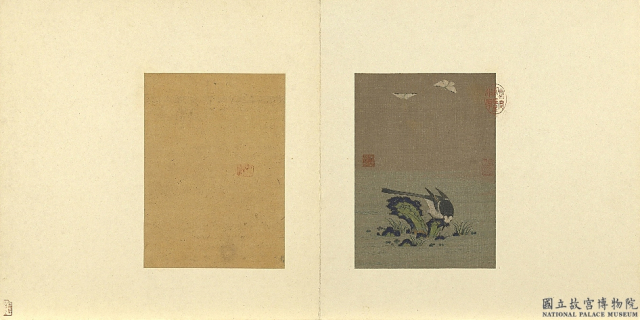鏤繪集錦 冊 鶺鴒
推薦分享
資源連結
連結到原始資料 (您即將開啟新視窗離開本站)後設資料
- 資料識別:
- 故絲000051N000000002
- 資料類型:
- 類型:緙繡
- 型式:靜態圖像
- 著作者:
- 朱克柔
- 主題與關鍵字:
- 鶺鴒 蝶蛾 溪澗、湍泉 荇藻 奇石 蝦
- 出版者:
- 數位化執行單位:國立故宮博物院
- 格式:
- 本幅 27.4x19.8公分
- 關聯:
- 緙織風華:宋代緙絲花鳥展圖錄,頁21-24&*故宮博物院緙絲,圖版4&*淺褐地設色織,鶺鴒一隻,站在河流中心的石塊上,注視著夾在石縫中的蝦子,蝴蝶飛舞,生動自然。利用「長短戧」織梭的伸展變化,產生暈色效果,皆能將鶺鴒多層次的羽色,或是蝦子腹部透明的亮度,表現得淋漓盡致。另外,大量運用二種不同色線配織,表現河水光影顏色的變化。幅左緙織工印一:朱克柔印。朱克柔名強,字剛,華亭縣(今上海松江)人。活動於南宋高宗(1127-1162在位)時,以女紅名世。此幅織法緊密勻整,技術精絕,為朱克柔精品。 &*Colored threads woven onto a light ochre background in this tapestry depict a wagtail standing on a rock in a stream. It is looking at a shrimp in the crevice of the rock as butterflies flit in this natural and vivid scene. Using “long and short propping” weaving shuttles to create variations, the effect is that of shaded colors conveying the multiple layers of feathers as well as the transparent brightness of the shrimp’s body. The result is a moist and luminous quality. Furthermore, there is a copious use of dual-colored thread that expresses variations in light and color on the water. Woven to the left in the work is a seal that reads, “Seal of Chu K’o-jou.” Chu K’o-jou, a native of Hua-t’ing (modern Sungkiang, Shanghai), had the personal name Ch’iang and the style name Kang. She was famous for her needlework and active in the era of the Southern Sung emperor Kao-tsung (r. 1127-1162). The weaving here is even and precise, and done with exceptional skill, making this a masterpiece in Chu’s name. This is the second leaf in the album “Collected Brocade of Carved Paintings.” &*1.童文娥,〈緙絲鶺鴒〉,收入童文娥主編,《緙絲風華 — 宋代緙絲花鳥展圖錄》(臺北:國立故宮博物院,2007年初版一刷),頁21。
- 管理權:
- 國立故宮博物院
授權聯絡窗口
- 國立故宮博物院圖像授權、出版授權、影音資料授權-申請流程說明
http://www.npm.gov.tw/zh-TW/Article.aspx?sNo=03003061






